 |
 |
 |
| |
RESPONSE TO DARUNAVIR/RITONAVIR (DRV/R) COMBINED WITH ENFUVIRTIDE (ENF)-CONTAINING ARV IN TRIPLE-CLASS EXPERIENCED PATIENTS WAS NOT PREDICTED BY BASELINE DARUNAVIR (DRV) SENSITIVITY OR VIRAL TROPISM (VT):
THE BLQ STUDY PRELIMINARY RESULTS
|
| |
| |
Reported by Jules Levin
4th IAS Conference
on HIV Pathogenesis,
Treatment and Prevention
22-25 July 2007
Sydney, Australia
Poster WePeB039
E DeJesus,1 A Zolopa,2 C Farthing,3 M Gottlieb,4 J Gathe,5 M Greenberg,6 and J Thommes7
1Orlando Immunology Center, Orlando, FL, USA; 2Stanford University Medical Center, Palo Alto, CA, USA; 3AIDS Healthcare Foundation, Los Angeles, CA, USA;
4Synergy Hematology Oncology Med. Assoc., Los Angeles, CA, USA; 5Therapeutic Concepts, Houston, TX, USA; 6Trimeris, Inc., Durham, NC, USA;
7Roche Laboratories, Nutley, NJ, USA.
Subset analyses from phase III studies in triple-class, antiretroviral (ARV)-experienced patients evaluating the efficacy and safety of darunavir/ritonavir (DRV/r) with an optimized background regimen demonstrated high rates
of virologic suppression when DRV/r was used with enfuvirtide (ENF).1
These published studies report that baseline DRV phenotypic sensitivity predicts virologic response in ARV-experienced patients treated with a DRV/r-containing regimen.1
The BLQ cohort study enrolled triple-class experienced patients experiencing virologic failure who had begun a new optimized regimen with ENF and DRV/r obtained before commercial availability through DRV expanded access in a predominantly community clinical setting, and was designed to explore the impact on virologic outcome of baseline factors such as DRV phenotypic sensitivity.
This protocol-defined interim analysis was conducted when the first half of the total cohort completed their week 24 assessments.
AUTHOR CONCLUSIONS
Treatment with ENF and DRV/r with OBT was generally well tolerated in this cohort with overall high 24-week virologic and CD4 responses that are consistent with previously reported 12-week results.3
The small dataset in this interim analysis might limit the power of logistic regression to identify predictors of virologic response other than baseline viral load.
Subsequent and comprehensive analysis of the complete cohort will be necessary to elucidate the potential impact of other factors (such as immune activation) on virologic outcome.
However, in triple-class experienced EAP patients, virologic responses at week 24 were uniformly excellent when DRV/r and ENF were combined with OBT in patients naive to these two drugs.
In this interim analysis, no differences in virologic response were seen across the range of baseline DRV phenotypes among patients receiving ENF and DRV/r with OBT.
Methods
Prospective, open-label, 24-week, single-arm, multicenter, cohort study conducted in the US and Australia.
Eligible patients (age ≥18 years) meeting the following inclusion criteria were enrolled:
--triple-class ARV-experienced
--ENF-naive
--DRV-naive, either enrolled in a DRV early access program or prescribed DRV
--HIV-1 RNA >2,000 copies/mL within 60 days.
At entry all patients switched their current failing ARV treatment to a regimen consisting of:
--ENF 90 mg twice daily (BID) self-administered as a subcutaneous injection
--DRV/r 600/100 mg BID
--other investigator-selected ARVs based on treatment history and resistance testing.
Phenotypic and genotypic resistances were assessed at baseline using the PhenoSense HIV drug susceptibility assay (Monogram Biosciences, South San Francisco, CA) and GeneSeq HIV genotypic assay (Monogram Biosciences). DRV phenotype was defined using EC50 fold-change (FC) standard scores.
CD4 and CD8 activation, analyzing the expression of surrogate immune activation markers CD38+ and HLA-DR+ in plasma samples taken at baseline and week 24, were assessed using multiparameter, polychromatic flow
cytometry-based assay strategies conducted at Duke University.
Co-receptor tropism (to CCR5 and CXCR4) was determined using the Trofile Assay (Monogram Biosciences).
Efficacy parameters included:
--virologic responses (percent of patients with HIV-1 RNA <50 copies/mL, <400 copies/mL, and HIV-1 RNA decrease from baseline >1 log10 copies/mL)
--mean change in log HIV-1 RNA from baseline
--mean change in CD4 count (cells/mm3) from baseline.
Safety parameters were assessed using descriptive statistics and focused on adverse events and serious adverse events leading to treatment discontinuation.
Stepwise logistic regression methods assessed the impact of the following baseline variables on week 24 virologic responses: genotypic susceptibility scores for OBT; DRV phenotypic sensitivity (EC50 FC); viral tropism; HIV-1 RNA;
CD4 counts; CD4 and CD8 activation (CD38+ and HLADR+); and number of prior ARVs used.
To better understand virologic response rates over the complete range of baseline DRV sensitivity phenotypes in this small dataset, we characterized responses in two ways:
-- DRV sensitivity utilizing categorical cut-offs previously cited in the literature1 (DRV FC<10, 10 to 40 and >40)
--DRV sensitivity ordered from lowest to highest values and then organized into three equal groups (low, medium and high tertiles).
-- This protocol-defined interim analysis of the efficacy and safety of DRV/r + ENF with optimized background treatment (OBT) was conducted when the first half of total patients enrolled (N = 135) completed their week 24 assessments.
Results
Patient Disposition
Of 63 eligible patients enrolled, 62 had at least one dose of trial medication and a safety follow-up at day 7 and were included in the safety analysis.
Discontinuations occurred among 14/63 (22.2%) patients enrolled.
Non-safety related: 11 (17.5%) due to the following:
--4 (6.3%) withdrew consent
--3 (4.8%) refused treatment
--2 (3.2%) failed to return
--1 (1.6%) entry criteria protocol violation
--1 (1.6%) administrative/other.
Safety related: 3 (4.8%) due to the following:
--2 (3.2%) adverse events - rash, upper gastrointestinal hemorrhage
--1 (1.6%) death (not related to trial medication).
--A total of 58 patients who received at least one dose of trial medication and received at least one post-baseline efficacy assessment at week 4 were included in the intent-to-treat (ITT) analysis.
Of the 58 patients in the ITT population, results for only 52 patients were available for phenotypic resistance to DRV. Six did not have phenotypable samples.
Patient Baseline Characteristics
The baseline characteristics of the first 63 patients enrolled are summarized in Table 1.
Table 1. Patient Baseline Characteristics (All Patients, n = 63).
40% had GSS=0, 27% GSS=1. Phenotypic DRV fold-change median 2.55 (-0.4-58.0). 75% phenotypic DRV fold-change <10, 19% >10- <40, 6% >40. Dual-mixed tropism 36%, CCR5: 24%, CXCR4: 1.7%, 21% not reportable.
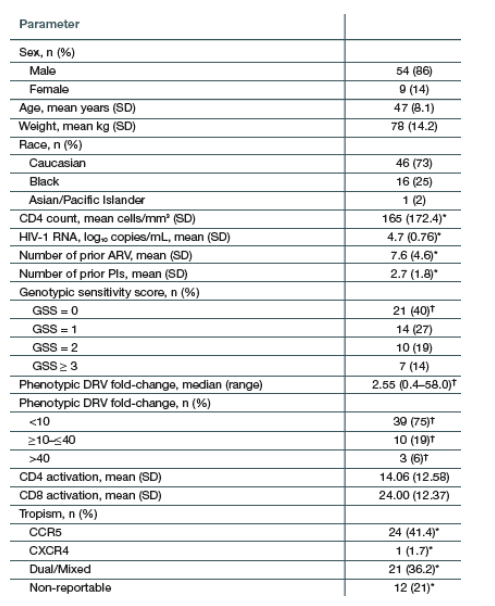
Virologic and Immunologic Responses (ITT Population)
Virologic responses after treatment with ENF + DRV with an OBT at week 24 were:
-- 64% of patients achieved <50 copies/mL
--78% of patients achieved <400 copies/mL
--86% of patients achieved >1 log10 unit drop
--mean log10 viral load decrease from baseline of -2.39.
When virologic response was analyzed as a function of DRV phenotype using FC cut-offs previously described,1 the percentage of patients achieving <50 copies/mL were: (Figure 1A)
-- 67% with baseline DRV FC <10
-- 70% with baseline DRV FC ≥10 to ≦40
--67% with baseline DRV FC >40
DRV phenotype was organized into three equal tertiles across the range of low (FC 0.40-1.07); medium (FC 1.17-5.23) and high tertile (FC 6.38-58.0) phenotypes.
The tertile analysis demonstrated response rates <50 copies/mL ranging from 61% to 77%, and <400 copies/mL ranging from 77% to 88% (Figure 1B).
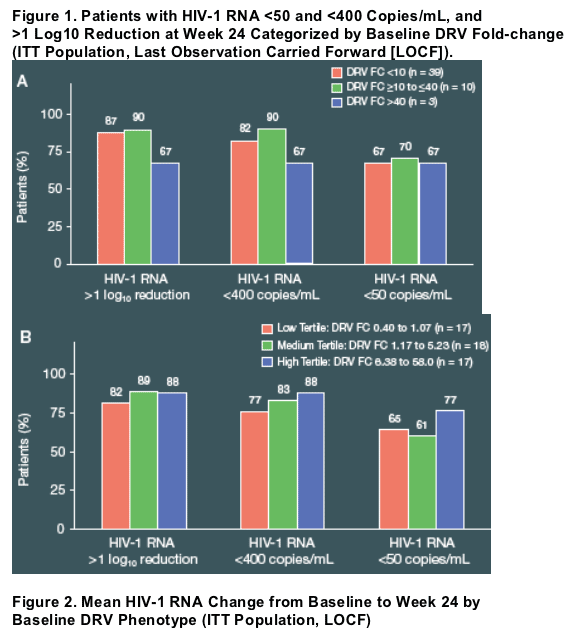
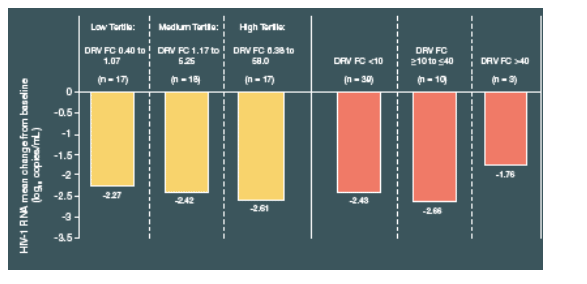
Viral load and CD4 responses at week 24 by baseline DRV phenotype are summarized in Figures 2 and 3, respectively.
Only 1 patient was found to have X4 tropism at baseline. At 24 weeks, this patient had a >1 log10 reduction in HIV-1 RNA to <50 copies/mL, with a mean log10 change from baseline of -1.33 and an increase from baseline CD4 counts of 95 cells/mm3, respectively. Virologic and CD4 response by co-receptor tropism are summarized in Table 2.
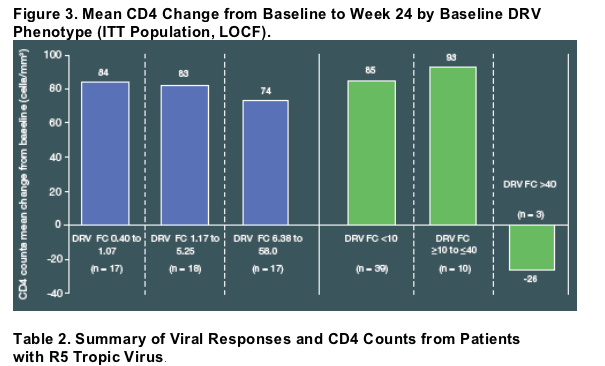
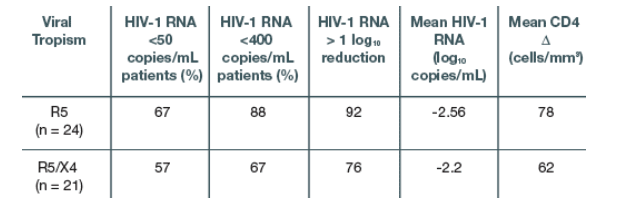
Multiple stepwise logistic regression of baseline factors demonstrated the impact on virologic response from baseline HIV-1 RNA (≦ or >5 log10 copies/mL) with an odds ratio of 0.101 (p<0.001), 0.165 (p=0.021) and 0.130 (p=0.020) for HIV-1 RNA <50 copies/mL, <400 copies/mL, and decrease of >1 log HIV-1 RNA from baseline, respectively.
Other baseline variables included in the model failed to identify predictors of virologic response: genotypic susceptibility score, DRV fold change, number of prior ARV treatments, CD4+ count, CD4+ activation percentage, CD8+ activation percentage, and viral tropism.
Injection Site Reactions
Although the study was not designed to compare injection site reaction (ISR) risk, the injection devices used were generally safe and well tolerated. No patients discontinued due to ISRs. More detailed information on ISRs has been
presented previously.2
Safety
Of 62 patients included in the safety analysis, a total of 11 serious adverse events occurred in 7 (11%) patients (Table 3). Two of these patients discontinued due to their adverse events (AEs).
An additional patient discontinued due to a rash not judged to be serious.
One death (unrelated to study drug) was reported in a patient with sepsis, worsening anemia, dyspnea, and worsening renal insufficiency.
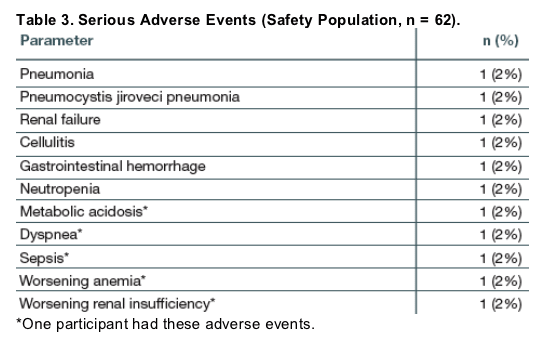
References
1. Clotet B, Bellos N, Molina J-M, et al. Efficacy and safety of darunavirritonavir at week 48 in treatment-experienced patients with HIV-1 infection in POWER 1 and 2: a pooled subgroup analysis of data from two randomized trials. Lancet. 2007; 369: 1169-78.
2. Gottlieb M, Farthing C, Guittari CJ and DeJesus E. Impact of patientselected
self-injection devices on the development of injection site reactions associated with enfuvirtide use. 9th International Workshop on Adverse Drug Reactions and Lipodystrophy in HIV, 19-21 July 2007; Sydney, Australia.
3. Farthing C, Gottlieb M, DeMasi RA, Thommes JA, DeJesus E. Impact of patient-selected self-injection devices on the development of injection site reactions associated with enfuvirtide use. Presented at HIV DART 2006, 10-14 December 2006; Cancun, Mexico.
|
| |
|
 |
 |
|
|